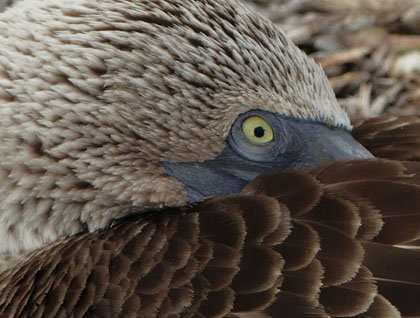Just as the morning started, we began our preparations. An early breakfast was ready for our early groups of photographers, and out they went, making a landing on North Seymour Island around 6:30 a.m. Not too long after, the rest of us also left the ship and made our way to the island. This is quite a place.
Although yesterday, arrival day, we got everyone off onto a beautiful white beach to decompress after long plane rides and days of travel, today was total immersion into the world of Galapagos. Right on landing we had the endemic swallow-tailed gulls clicking and churring among themselves, and frigatebirds both magnificent and great, flying inches above our heads as they caught the up-draft coming off the low bluff we had just climbed. Blue-footed boobies were nesting, many nests with two eggs (no chicks yet, apparently). A few males were still searching for mates, sky-pointing at fly-overs, doing victory laps in the air to land with bright feet spread for effect. We didn’t see any females overly impressed.
Frigate males were also looking for love with their red pouches inflated, however not all will be successful this year. As every year, there are always unsuccessful males, the unbalanced sex ratio keeping sexual selection going strong. Natural selection and sexual selection here in the islands are both easily seen every day, all day – it is not an easy life.
Land iguanas crossed the trail over sand and rock, under bushes and around trunks, orange and yellow, these terrestrial reptiles are unique to Galapagos, and this population on North Seymour has a particularly interesting history. Brought over by humans in the 1930s from Baltra next door, without these experimental transferals decades ago these particular land iguanas would have gone extinct. Fortunately since then, the Galapagos National Park Service with the help of researchers from the Charles Darwin Foundation, have worked to allow the population to increase once more, eradicated the threats to their survival (rats mostly), and re-introduced them to their home island of Baltra.
Our afternoon was spent visiting an entirely different island – about three hours sail west from North Seymour, the island of Rabida. The volcanic source that created this island carried more than the usual amount of iron. As a consequence, over the millennia the iron oxide has given the island a red hue unmistakable and unseen in any other island of the Galapagos.
But it was time to get wet, so snorkeling came first and off we went. In order get some practice with borrowed equipment, those with little or no previous snorkeling experience, used the red beach itself as their snorkeling spot. Our youngest guests of only a few years old had a blast there too. Gentle surf allowed for some serious paddling around.
Those with confidence in their abilities to swim and snorkel went for the deep-water adventure and came back with stories of sharks, turtles, wrasses and sea lions. It really couldn’t have been much better for a first exploration into the Galapagos Marine reserve.
Late afternoon, those with still more energy to expend went ashore on the red beach for a walk. The clear sky allowed the sun lowering in the west to light up the red sand until it glowed. With a backdrop of green vegetation and blue sky, it is an image that only Rabida can provide, nowhere else in the world.
Late night after dinner, the ship pulled up alongside the coast off-shore Wolf Volcano. On our planned route, how could we not stop for a moment to see what was happening with the eruption? We had already seen from a long distance away the red clouds of pyro-cumulous formation. It was obvious that a vent was still active on the inside of the caldera, but on the outside no rivers or streams of molten material were visible any longer. Who knows where Wolf Volcano will go with this in the next weeks to come?







